Top 1 Cottage Cheese Alfredo Sauce Recipe for Busy Nights!
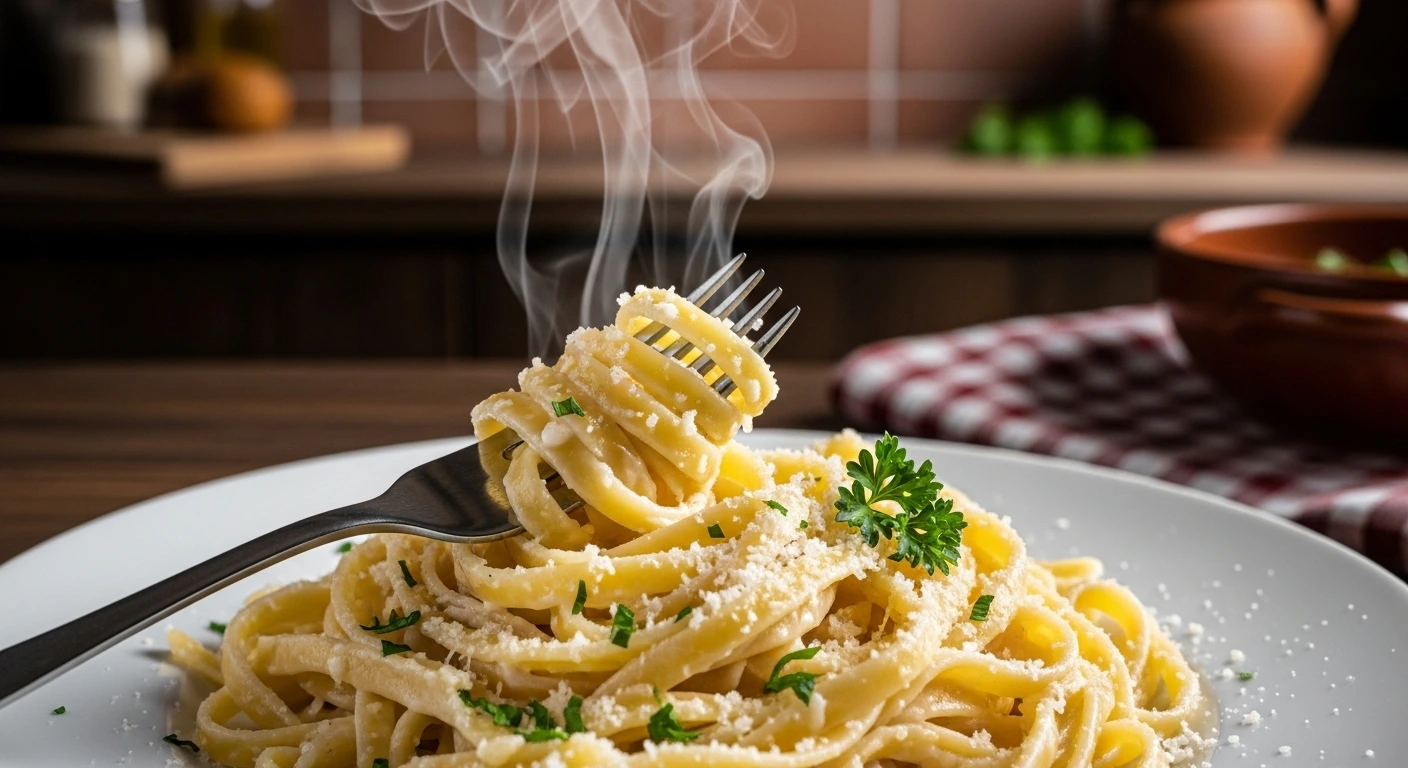
Welcome — you’ve just landed on the easiest way to get a luscious, restaurant-style Alfredo on the table without heavy cream, guilt, or an hour of hovering over a stove. If you love creamy pasta but hate the heaviness of traditional Alfredo, this cottage cheese alfredo sauce is about to become your weeknight hero. It’s high in protein, quick to make, and flexible enough to bend to whatever’s in your fridge. Sound good? Let’s dive in.
Table of Contents
Introduction — Why This Cottage Cheese Alfredo Sauce Is a Game-Changer
Think of classic Alfredo: butter, heavy cream, mountains of Parmesan, and a finish that leaves you loopy with richness. That’s bliss for a special occasion, but weeknights demand something different — something fast, satisfying, and smarter for your body. Enter cottage cheese. Yes, cottage cheese — that humble, curdled dairy that most people only think of at brunch or in a diet plan. When pureed until silky, cottage cheese transforms into a velvety, creamy base that mimics heavy cream without the same calorie load or grease slick.
Why choose this route? Three big reasons:
- Nutrition without compromise. Cottage cheese brings protein and calcium, making your sauce a genuine meal booster. It’s a healthy alfredo sauce alternative that actually improves the nutritional profile of your pasta.
- Speed and simplicity. Most versions take ten to fifteen minutes from start to finish. If you can boil water and press a button on your blender, you can make this.
- Versatility. Want to deepen the flavor? Add cream cheese for an even richer mouthfeel (see the section on alfredo sauce with cream cheese). Need a vegan option? There’s a path to a dairy free alfredo sauce using cashews or a store-bought base like Bertolli (we’ll cover how to incorporate bertolli alfredo sauce as a shortcut).
This recipe isn’t a compromise; it’s a clever pivot. Think of it as turning a sedan into a sports car — same destination (creamy pasta joy), but with better handling and fewer trade-offs.
Why You’ll Love This Healthy Alfredo Sauce
Before we jump into the ingredients and method, let’s be concrete about what makes this version special. If you’ve tried low-fat substitutes before and ended up with a grainy, thin sauce, you’re not alone. The trick here is texture management and flavor layering.
- Protein-rich base: Cottage cheese supplies substantial protein, so this sauce plays nicely for people focused on muscle maintenance or simply wanting a more satiating dinner. Unlike cream-only sauces, this one helps keep you full.
- Lower in saturated fat: Heavy cream is essentially fat by volume. Replacing it with cottage cheese cuts saturated fat markedly, while still delivering that indulgent mouthfeel once blended.
- Customizable creaminess: If you want decadence, a small wedge of cream cheese (or a dollop of mascarpone) will make the sauce silkiest. If you want lighter, milk or broth thins the sauce elegantly.
- Better for leftovers: Because cottage cheese-based sauce stabilizes differently than cream, it reheats gracefully with the right technique — a simmer with a splash of water or milk and a quick whisk restores it.
So yes, it’s healthy, but it’s also a practical, crave-satisfying answer for busy people who refuse to eat boring dinners.
Ingredients You’ll Need
Per your blog preferences, here’s the ingredients table for clarity and easy scanning. Use the amounts below for 4 servings (enough for a pound of pasta).
| Ingredient | Amount | Purpose / Notes |
|---|---|---|
| Cottage cheese (full-fat or low-fat) | 1 ¾ cups (about 420 g) | Base of the sauce — blends to creamy texture |
| Freshly grated Parmesan cheese | 3/4 cup (75 g) | Adds umami and classic Alfredo flavor |
| Garlic cloves | 2 medium | Minced, or use 1 tsp garlic powder if in a hurry |
| Milk (or unsweetened plant milk for dairy-free) | 1/4–1/2 cup | Adjusts consistency; use broth for lighter sauce |
| Butter or olive oil | 1–2 tbsp | Butter for richness, olive oil for lighter/dairy-free |
| Lemon juice | 1 tsp | Brightens the sauce, balances richness |
| Salt | to taste | Start with 1/2 tsp, adjust after Parmesan |
| Freshly ground black pepper | to taste | Adds a subtle bite |
| Optional: cream cheese | 2 oz (56 g) | For alfredo sauce with cream cheese extra silkiness |
| Optional: nutmeg | a pinch | Traditional Alfredo nuance — use sparingly |
| Optional: fresh parsley | 1 tbsp chopped | For garnish and freshness |
Notes on Dairy-Free Version: To make this a dairy free alfredo sauce, swap the cottage cheese for a blended cashew cream (soak 1 cup raw cashews for 4 hours, drain, blend with 1 cup water until smooth). Replace Parmesan with a nutritional yeast + salt mix or a store-bought vegan Parmesan. Use olive oil instead of butter.
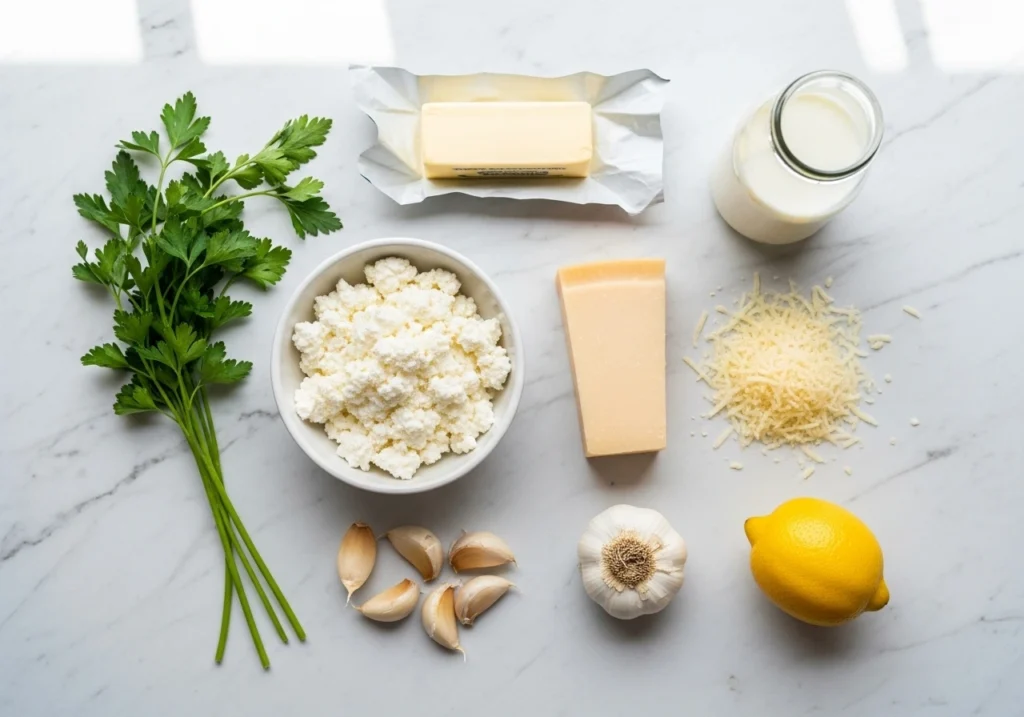
Kitchen Tools Needed
| Tool | Why you need it |
|---|---|
| Blender or food processor | Essential to puree cottage cheese into a silken sauce |
| Saucepan (medium) | To gently heat and thicken the sauce |
| Whisk | For gentle, even thickening while heating |
| Measuring cups & spoons | For accurate, repeatable results |
| Pasta pot and colander | For cooking and draining the pasta |
| Microplane or fine grater | For freshly grating Parmesan (best flavor) |
Pro tip: a high-speed blender will get you the silkiest texture, but a regular blender or food processor works fine — just run it longer and scrape the sides.
Step-by-Step Guide: How to Make Cottage Cheese Alfredo Sauce (Overview)
I’ll walk you through a full, failproof version that yields a rich, creamy, balanced sauce without curdling or graininess. This recipe assumes you’re making sauce for 1 pound (450 g) of pasta, serving 4 hungry people.
High-level steps:
- Blend the base: Puree cottage cheese, milk, garlic, lemon juice, and a pinch of salt until velvety smooth.
- Warm and marry flavors: Gently heat the puree with butter or oil in a saucepan, whisking constantly until it thickens slightly.
- Finish with cheese: Remove from heat and whisk in freshly grated Parmesan until melted and cohesive.
- Toss and serve: Combine with hot, drained pasta and a splash of pasta water to bind. Finish with pepper and parsley.
I’ll explain each step in detail, including temperature cues, texture signals, and recovery tips if something looks off. Ready? Let’s get specific.
Step 1 — Prepare the base: blending for silk
Place the cottage cheese, 1/4 cup milk, garlic, lemon juice, and a pinch of salt into the blender. Pulse at first to break down curds, then blend continuously for 45–60 seconds. The aim is a texture similar to thick cream — smooth, glossy, no visible lumps.
Why blend instead of whisk? Cottage cheese curds must be sheared aggressively to form a homogeneous emulsion. Blending minimizes graininess and creates the illusion of heavy cream.
If you prefer a more relaxed texture, or if you don’t own a blender, you can use an immersion blender right in a deep mixing bowl. It will take a little longer but will still produce excellent results.
Texture check: Scoop a spoonful onto a plate. It should coat the spoon in a thick ribbon without breaking apart. If it looks too thick, add another tablespoon of milk. If it’s thin, no worries — it will thicken when heated and when Parmesan is added.
Step 2 — Heat gently; don’t boil
Transfer the blended mixture to a medium saucepan set over low to medium-low heat. Add butter or olive oil. Heat slowly — you want the sauce just warm enough to encourage the proteins to relax and the fat to emulsify, not to scald them.
Use a whisk and stir continuously. After a few minutes you’ll see the sauce gloss up and thicken a touch. This is the moment to add a pinch of nutmeg if you like that classic Italian touch.
Important caution: High heat can make dairy separate and become oily. Keep the flame modest and whisk. This isn’t a boil-and-throw recipe — it’s a slow coaxing of flavors into a smooth partnership.
Step 3 — Add the Parmesan and finish off-heat
Once the sauce feels silky and slightly thickened, remove the pan from heat. Add the freshly grated Parmesan in small increments, whisking until each batch melts before adding more. Parmesan is where the magic happens: it builds body, salt, and that unmistakable umami backbone.
If you want indulgence beyond indulgence, stir in the optional cream cheese now — it will melt quickly into the warm sauce and make it nearly indistinguishable from a heavy-cream version.
Adjust for salt: Because Parmesan brings salt, taste before adding anything extra. You’ll probably need little to none.
Step 4 — Toss with pasta and serve (overview)
Reserve a cup of pasta water before draining your pasta. Combine the hot, drained pasta with the sauce in the saucepan or a large mixing bowl. Add a few tablespoons of reserved pasta water — the starch in the water helps the sauce cling to the noodles and builds a glossy finish.
Finish with freshly ground black pepper and chopped parsley. Serve immediately.
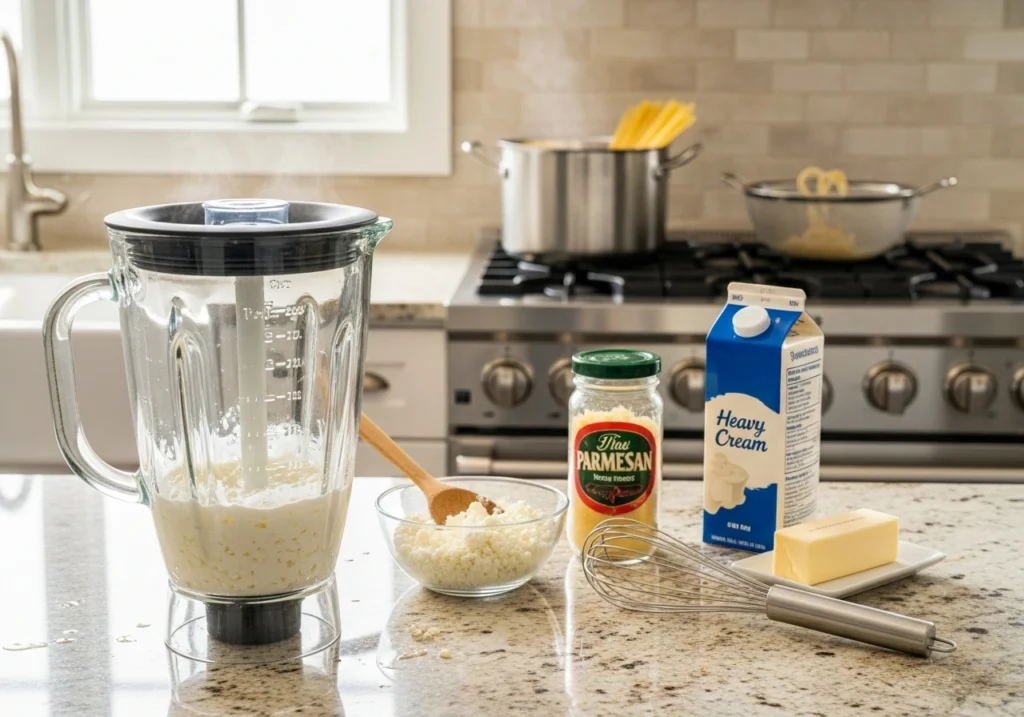
Ingredient Variations and Substitutions
No one kitchen looks the same, and that’s part of the fun. The beauty of this sauce is how forgiving and adaptable it is. Here’s how to change it up depending on your mood, pantry, or dietary needs.
Make It Extra Creamy – Alfredo Sauce with Cream Cheese
If you’re craving that velvety, restaurant-style texture, cream cheese is your best ally. Add 2–3 ounces of softened cream cheese when blending the cottage cheese base. It smooths the edges, enriches the flavor, and thickens the sauce naturally. This version is perfect when you want that “I can’t believe this isn’t restaurant Alfredo” moment.
Go Dairy-Free – Vegan Alfredo Sauce Option
Want to ditch dairy but keep the creaminess? Replace the cottage cheese with cashew cream (blend 1 cup soaked cashews + 1 cup water until silky). Substitute butter with olive oil or vegan butter, and swap Parmesan with nutritional yeast plus a pinch of salt. The result is a dairy free Alfredo sauce that’s still smooth, garlicky, and indulgent.
Shortcut Hack – Boost with Bertolli Alfredo Sauce
If you already have a jar of Bertolli Alfredo sauce, use it as a base. Combine 1/2 cup Bertolli with your cottage cheese mixture for extra depth and convenience. The flavors complement each other beautifully, and it gives you a backup when you’re short on Parmesan or time.
Flavor Boost Ideas
- Add roasted garlic instead of raw for a subtle sweetness.
- Toss in a handful of sautéed mushrooms for umami depth.
- Spice lovers can mix in crushed red pepper flakes for a gentle kick.
- Stir in chopped spinach or kale at the end for a nutritious twist.
Pro Tips for the Creamiest Cottage Cheese Alfredo Sauce
Even the simplest recipe can shine brighter with a few pro-level tricks. These ensure your healthy Alfredo sauce turns out silky and restaurant-worthy every single time.
- Blend until completely smooth. Don’t stop blending too early. Cottage cheese curds need time to emulsify — a full minute in a strong blender will make a world of difference.
- Warm gently, never boil. Boiling breaks emulsions and causes curdling. Think of heat like a gentle hug, not a slap.
- Use freshly grated Parmesan. Pre-shredded cheese contains anti-caking agents that prevent smooth melting. Grate your own for a luscious finish.
- Reserve pasta water. That starchy liquid helps your sauce cling beautifully to noodles while adding gloss.
- Taste and adjust. Every Parmesan is different in saltiness, so fine-tune seasoning at the end.
Serving Ideas for This Healthy Alfredo Sauce
This sauce isn’t just for fettuccine. It’s a multitasker — creamy enough for pasta, versatile enough for proteins, and light enough for vegetables. Try these serving ideas:
- Classic Fettuccine Alfredo: Toss hot fettuccine with the sauce and garnish with extra Parmesan and parsley.
- Pasta Primavera: Mix the sauce with steamed broccoli, carrots, and bell peppers for a wholesome dinner.
- Chicken Alfredo Bake: Layer cooked pasta, grilled chicken, and sauce in a baking dish. Top with mozzarella, bake until bubbly.
- Zoodle Alfredo: Replace pasta with spiralized zucchini for a lighter, low-carb meal.
- Veggie Dip or Spread: Use the sauce cold as a high-protein dip for roasted veggies or as a sandwich spread.
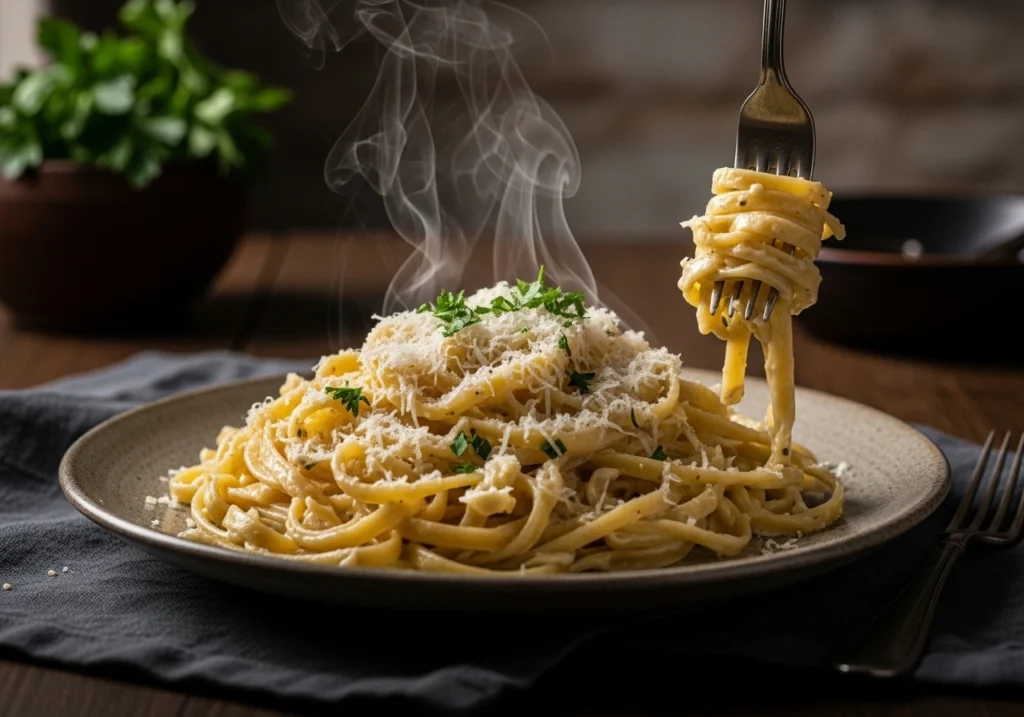
Storage and Reheating Tips
Cottage cheese Alfredo sauce stores surprisingly well — as long as you handle it gently when reheating.
Refrigeration
Store leftover sauce in an airtight container in the fridge for up to 4 days. The sauce may thicken slightly after chilling, but that’s normal.
Reheating
Warm the sauce slowly over low heat on the stovetop. Add a splash of milk or water to loosen it. Stir constantly until smooth and heated through. Avoid microwaving, which can separate the sauce.
Freezing
Yes, you can freeze it, though the texture may shift slightly. To freeze, pour cooled sauce into freezer-safe bags or containers. Reheat gently, whisking to restore creaminess.
Pro Reheating Tip: Add a teaspoon of butter or olive oil while warming to refresh the silky texture.
Nutritional Information and Health Benefits
Let’s talk numbers. Compared to traditional Alfredo, which can hit 700 calories per serving, this cottage cheese Alfredo sauce version comes in much lighter.
| Nutrient | Amount (approx., per serving) | Traditional Alfredo Comparison |
|---|---|---|
| Calories | 260–300 | 600–700 |
| Protein | 20–25 g | 8–10 g |
| Fat | 14 g | 40–50 g |
| Carbohydrates | 6–8 g | 8–10 g |
| Calcium | High | Moderate |
| Fiber | Minimal | Minimal |
What this means: you’re eating real food with fewer calories and way more protein. Cottage cheese gives this sauce its edge — it’s a stealthy muscle-building ingredient hiding inside a comfort food disguise.
FAQs About Cottage Cheese Alfredo Sauce
1. Can I use low-fat or fat-free cottage cheese?
Yes, but expect a slightly thinner sauce. Full-fat gives the best mouthfeel, but low-fat works well if you blend thoroughly and adjust with Parmesan.
2. How does it compare to Bertolli Alfredo sauce?
Bertolli is rich and buttery, great for indulgent meals. This cottage cheese version is lighter, fresher, and higher in protein — think comfort with a conscience.
3. Can I make it dairy-free or vegan?
Absolutely. Use cashew cream or silken tofu for the base, olive oil instead of butter, and nutritional yeast for cheesy flavor.
4. What pasta works best with this sauce?
Fettuccine, linguine, penne, or spaghetti all pair beautifully. The sauce clings well to both flat and tubular shapes.
5. Can I use cream cheese instead of cottage cheese?
Yes, but cream cheese is richer and heavier. You’ll end up closer to classic Alfredo in texture and calories.
Comparison: Traditional vs. Cottage Cheese Alfredo Sauce
| Feature | Traditional Alfredo | Cottage Cheese Alfredo |
|---|---|---|
| Main base | Heavy cream & butter | Blended cottage cheese |
| Calories | High | Moderate to low |
| Texture | Very rich, heavy | Smooth, light, and creamy |
| Prep time | 20–25 minutes | 10–12 minutes |
| Protein content | Low | High |
| Best for | Occasional treat | Everyday meal |
This table alone should convince even die-hard traditionalists to give it a try. You get that same silky, comforting coating on your pasta without the post-meal heaviness.
Conclusion – The Best Healthy Alfredo Sauce for Busy Nights
When you can make a healthy Alfredo sauce that feels indulgent, tastes luxurious, and takes less than fifteen minutes, you’ve hit culinary gold. This cottage cheese Alfredo sauce proves that comfort food doesn’t need to be loaded with cream or guilt.
It’s ideal for busy weeknights, flexible enough for different diets, and delicious enough to convert skeptics. Whether you’re using it as a pasta topper, veggie dip, or casserole base, it’s the sauce you’ll keep returning to.
If you loved this recipe, check out my post on How to Make Healthy Banana Bread (Easy & Nutritious!) for another guilt-free classic you’ll love.
And for more insights on the nutritional benefits of dairy proteins, visit Harvard Health Publishing – Dairy and Health.
Your next weeknight dinner just got easier — and tastier.
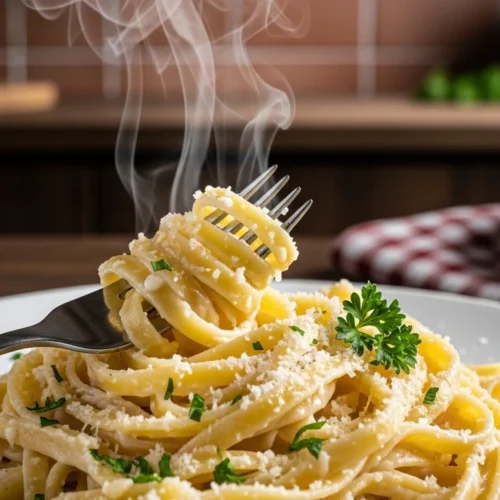
Top 1 Cottage Cheese Alfredo Sauce Recipe for Busy Nights!
Ingredients
- 1 ¾ cups 420 g cottage cheese — full-fat or low-fat
- ¾ cup 75 g freshly grated Parmesan cheese
- 2 medium garlic cloves minced (or 1 teaspoon garlic powder)
- ¼ –½ cup milk or unsweetened plant-based milk for desired consistency
- 1 –2 tablespoons butter or olive oil use olive oil for dairy-free version
- 1 teaspoon lemon juice for brightness
- ½ teaspoon salt adjust to taste
- Freshly ground black pepper to taste
- Optional: 2 ounces 56 g cream cheese for extra creaminess
- Optional: A pinch of nutmeg for a classic Alfredo aroma
- Optional: 1 tablespoon fresh chopped parsley for garnish
Instructions
Blend the Base:
- In a blender, combine cottage cheese, milk, garlic, lemon juice, and a pinch of salt. Blend until completely smooth and creamy (about 1 minute).
Warm the Sauce:
- Transfer the blended mixture to a medium saucepan. Add butter or olive oil. Heat gently over low-medium heat while whisking constantly until it begins to thicken slightly.
Add Cheese:
- Remove the pan from heat. Stir in freshly grated Parmesan (and optional cream cheese). Whisk until fully melted and smooth.
Adjust Consistency:
- If the sauce is too thick, whisk in a tablespoon or two of milk until it reaches your desired creaminess.
Combine with Pasta:
- Toss hot cooked pasta with the sauce. Add a little reserved pasta water if needed to loosen it.
Season and Serve:
- Finish with salt, black pepper, and fresh parsley. Serve immediately and enjoy!
Notes
- For a dairy-free version, replace cottage cheese with cashew cream (1 cup soaked cashews blended with 1 cup water), butter with olive oil, and Parmesan with nutritional yeast.
- For a creamier variation, add cream cheese while blending.
- For a quick shortcut, mix ½ cup Bertolli Alfredo sauce with the blended cottage cheese base for extra depth.
- Store leftovers in the fridge for up to 4 days. Reheat gently with a splash of milk or water.
Review Our Recipe: Your Feedback Makes a Difference
There are no reviews yet. Be the first one to write one.
